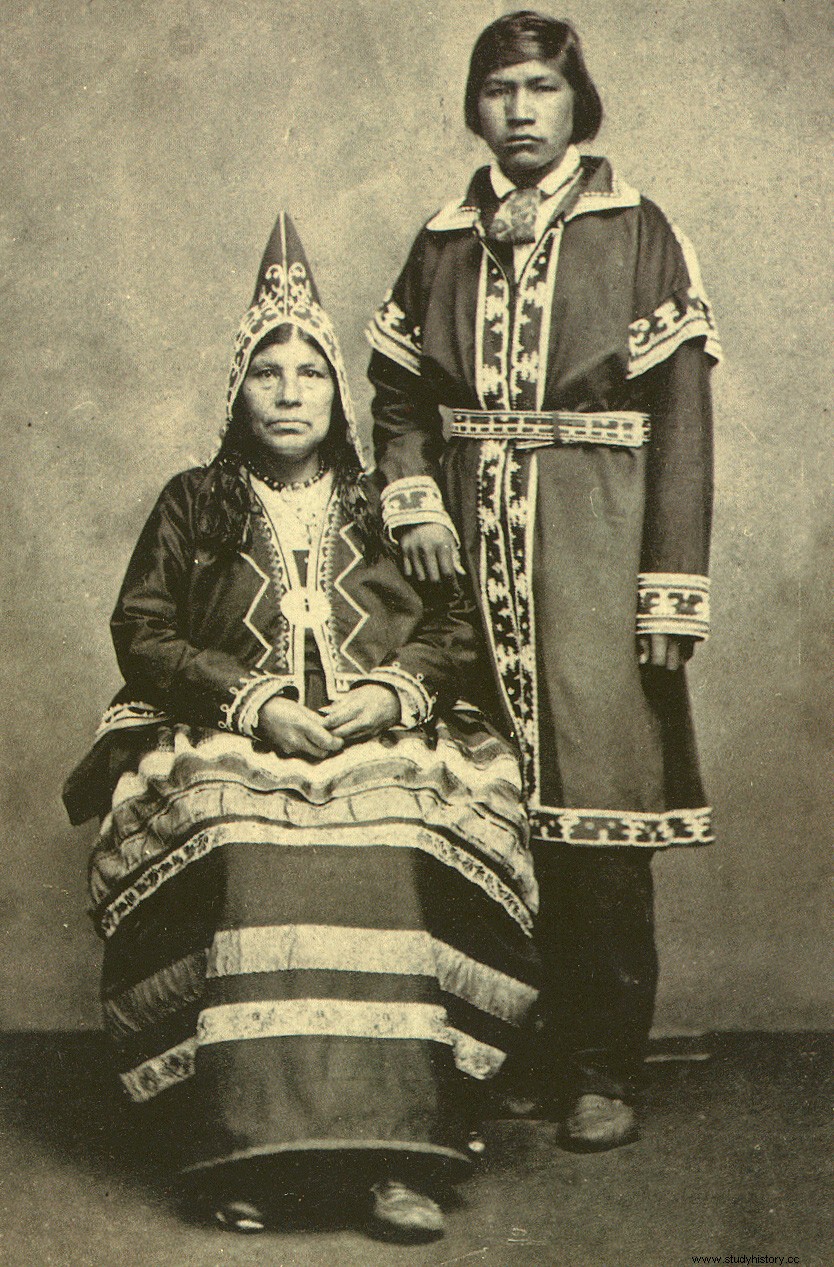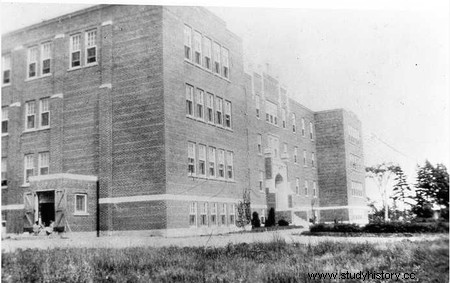Member of the Mi’kmaq people in Canada, Nora Bernard (1935 – 2007) revolted against the system of forced residential schools for Aboriginal children. The class action it is launching will result in compensation for approximately 79,000 victims.
The Mi’kmaq

The second of six children, Nora Bernard was born on September 22, 1935 in Nova Scotia. She is a member of the Algonquian Mi'kmaq people. Arriving in the region ten thousand years earlier via the Bering Strait, the Mi’kmaq – whose name means “my brother” or “my friend” – inhabit the maritime provinces of Canada and Gaspésie. Before the arrival of European settlers, they lived by hunting, fishing and gathering according to the seasons; they travel in birchbark canoes on the many waterways that cross their heavily forested territory with very cold winters. The Mi'kmaq live in wigwam, conical habitats made of a wooden trellis, covered with branches, bark or even animal skins.
The Mi’kmaq are among the first peoples of North America to come into contact with explorers and then European settlers from the 15th th century; they establish fur trading relations with the French. During English and French colonization and in the 18 th century in particular, wars broke out between British settlers and the Mi’kmaq, who allied themselves with the French. The British set up native reserves, forcing the Mi'kmaqs to a semi-sedentarization and profound changes in their way of life. Across Canada, indigenous peoples are victims of abuses, induced famines, executions, deprivation of liberty, confiscation of land, forced assimilation. As early as 1820, the federal government set up “native boarding schools“, which the children were forced to attend and in which the culture and language of the settlers were imposed on them.
Indigenous boarding schools
When Nora Bernard reaches the age of nine, the authorities make it clear to her mother that if she does not agree to send her children to boarding school, she will lose custody of them. Nora and her siblings were then sent to the Shubenacadie Indian Residential School in Nova Scotia; the little girl witnesses the abuse and cruel treatment inflicted on indigenous children forced to attend the institution.

The students of the boarding school learn English and are not allowed to speak the language of their people, which they are gradually losing. “Eventually we lost our language. After four years there, at a young age, you lose your language. » (We ended up losing our language. After four years there, at a young age, we lose our language ) explains Mi’kmaq chief Ben Sylliboy, who was educated during the same period. In addition to forced cultural assimilation, Nora witnesses physical and sexual abuse, as well as lack of medical care, food deprivation and confiscation of clothing. “It was no place for a child she would later say, “Once you entered those big doors in the front and they slammed behind you, it was just like going into prison. (This was no place for a child. Once you walked through those big doors at the entrance and they slammed shut behind you, it was like going to jail ).
Due to overcrowding and lack of care, tuberculosis spreads in the classrooms and takes a heavy toll. It is estimated that between 3,000 and 6,000 children die in these boarding schools; a number impossible to know with certainty, in particular because the adjoining cemeteries, with anonymous graves, have often been razed, intentionally concealed or covered by constructions.
At the boarding school, Nora strives to defend children who are victims of abuse. Her little sister, Linda, testifies:“If she saw any of us being handled roughly, she fought the nuns. If she was in the kitchen, she'd get food for my youngest brother, Albert. I recall beats, but nothing like Nora. She suffered for all of us. (If she saw any of us being mistreated, she would fight the nuns. If she was in the kitchen, she would take food for my youngest brother, Albert. I remember beatings, but nothing like what Nora went through. She suffered for all of us ). Nora will spend five years at boarding school.
A single mother
In 1955, Nora Bernard married a non-Aboriginal man. According to the Indian Act ("Indian Act") of 1876, this marriage made her lose her status as an "Indian" and Nora had to leave the reserve in which she was born and in which her family lived; an exclusion that causes her great suffering, but which does not prevent her from helping her community while raising her six children.
His daughter Natalie testifies as follows:“[A neighbor] mentioned to mom that she didn’t have Pampers for her baby and mom went right out and bought her some even though she was a single mom herself and raising six kids. That's how she was. She shared everything she had. And she always stuck up for people who couldn't help themselves. (A neighbor told my mom she didn't have any diapers for her baby, and my mom immediately went to buy some for her, even though she herself was a single mother raising six children. It's like that's who she was. She shared everything she had. And she always fought for those who couldn't fight back).

The largest class action lawsuit in Canadian history
As time passes, Nora Bernard does not forget what she and her family went through at residential school, nor the hardships faced by her people. By dint of mistreatment and spoliation, former students often experience problems of poverty, alcohol, drugs, violence, suicide. Among other responsibilities and commitments, Nora created and chaired an association dedicated to the victims of the Shubenacadie residential school. She meets the victims, brings them together to encourage them to break the silence, collects their testimonies. She wants to do them justice. Nora quickly considered legal action but, in 1990, no law firm agreed to take on the case. It was not until 1996 that she managed to convince lawyer John McKiggan to represent the victims of the Shubenacadie residential school in their complaint against the federal government.
When the complaint becomes public knowledge, it quickly snowballs. Throughout the country, associations of victims of other residential schools are launching similar actions. In Canada, 150,000 children – about 10% of Mi'kmaq children and 30% of Indigenous children – went through one of 139 residential schools, the last of which did not close until 1996. These complaints eventually coalesce into one, which becomes the largest class action lawsuit in Canadian history. In 2006, the Indian Residential Schools Settlement Agreement (the Residential Schools Agreement) acknowledges the harm done to Indigenous communities and awards two billion dollars in compensation to approximately 79,000 victims:an average compensation of $25,000 for each former student, rising up to $250,000 for those who can prove physical or sexual abuse. This is the largest settlement following a class action lawsuit in Canada.
In December 2007, Nora receives her compensation, which amounts to 14,000 dollars. Although the Indian Act was repealed in 1985, she did not regain her place within the community and the reserve until March 2007. A few days after Christmas, Nora Bernard was found murdered at her home, at the age of seventy-two. His grandson, James Gload, will later be convicted for this murder; at the time of the crime, he was under the influence of several drugs.
